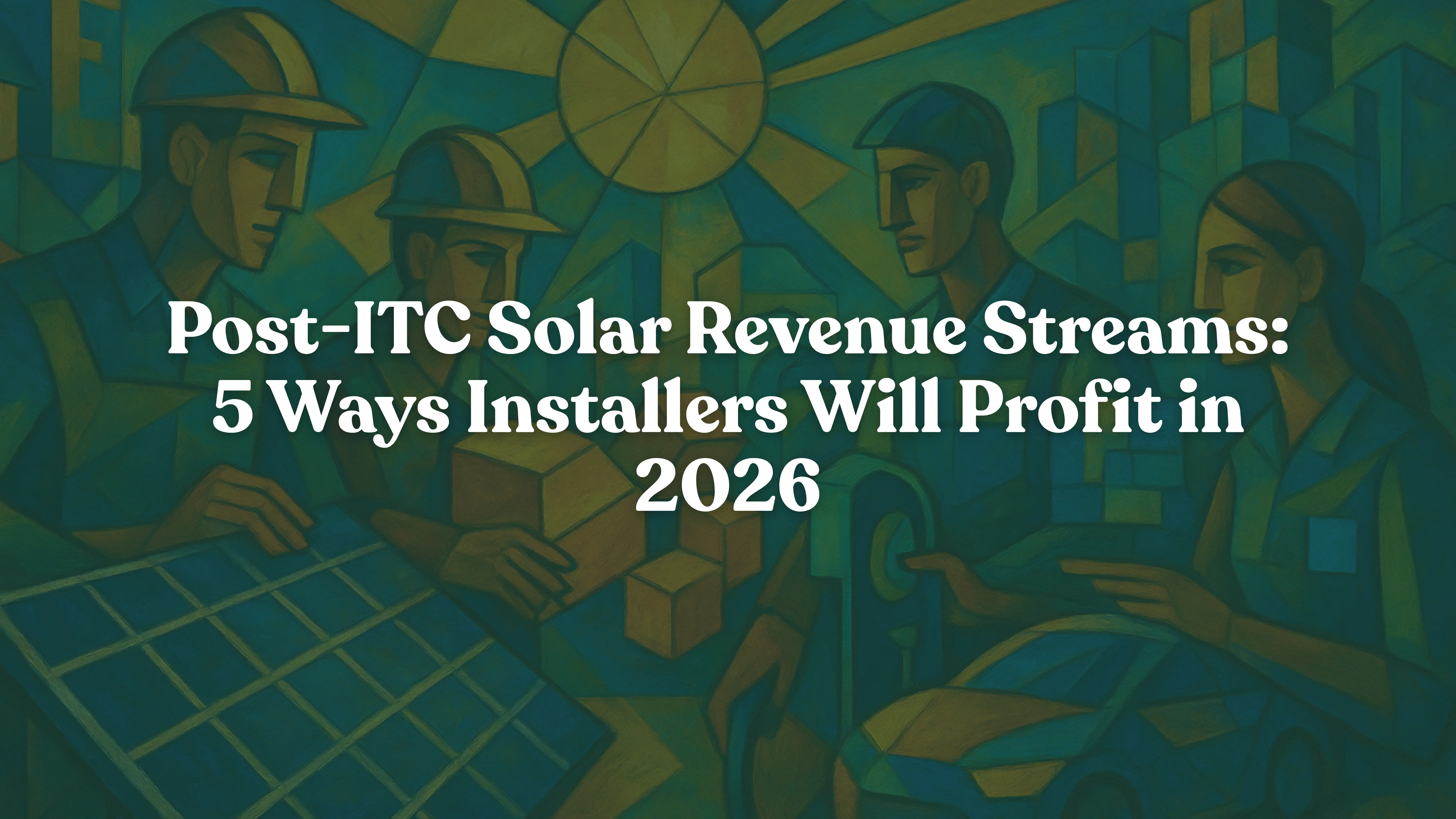5 Post-ITC Solar Revenue Streams That Work in 2026

How Solar Installers Will Thrive After the Residential ITC Ends: 5 Profitable Revenue Streams for 2026, Post-ITC Solar Revenue Streams.
The residential solar tax credit ends December 31, 2025, but solar installers can thrive through five key post-ITC solar revenue streams. Commercial projects remain eligible for 30% tax credits through 2032. Battery storage installations grew 28% in operations and maintenance alone. EV charging infrastructure and energy-as-a-service models offer recurring revenue. Smart installers are already diversifying beyond residential installations.
Understanding the Post-ITC Solar Market in 2026
The residential solar Investment Tax Credit officially ends on December 31, 2025. According to the Solar Energy Industries Association (SEIA), there will be no phase-down period. The 30% credit simply disappears for homeowner-owned systems.
This represents a fundamental shift for installers. However, the solar industry continues to grow despite policy changes. Solar accounted for 56% of all new electricity-generating capacity in the first half of 2025, as reported by SEIA’s Solar Market Insight Report.
The key question becomes: what are the most viable post-ITC solar revenue streams for your installation business? Let me walk you through five proven opportunities that successful installers are already implementing.
Revenue Stream #1: Commercial and Industrial Solar Projects
The commercial Investment Tax Credit remains at 30% for projects beginning construction before July 4, 2026. This creates immediate opportunities for installers willing to shift focus toward business clients.
Commercial solar installations set second-quarter records in 2025. The segment grew by 27% compared to the previous year, according to SEIA’s Q2 2025 market data. Businesses facing rising electricity costs increasingly view solar as essential infrastructure.

The profit margins on commercial projects typically exceed residential installations. You work with larger systems and fewer customer interactions per kilowatt installed. Business clients understand return on investment calculations. They make purchasing decisions based on financial metrics rather than environmental preferences alone.
Target these specific commercial segments for the best results. Manufacturing facilities consume significant daytime electricity. Warehouses offer expansive roof space perfect for solar arrays. Agricultural operations need energy solutions for irrigation and processing. Schools and nonprofits can access special incentive programs.
Commercial clients often structure deals through power purchase agreements. They may pursue direct purchases or tax equity arrangements. Your installation business benefits from understanding these financing mechanisms.
Revenue Stream #2: Battery Energy Storage Systems
Battery storage represents one of the fastest-growing post-ITC solar revenue streams available to installers today. Approximately 92% of residential installers offered energy storage installation in 2024, according to SolarReviews’ industry survey data.
Operations and maintenance jobs in battery storage increased by 28% in recent years. This reflects the growing installed base of storage systems needing professional service. The Interstate Renewable Energy Council tracks these employment trends in their solar jobs census.
Customers increasingly choose battery storage primarily for backup power during outages. Grid reliability concerns continue growing nationwide. Battery systems offer compelling value propositions that don’t depend on federal tax credits to make financial sense.
The commercial battery storage market offers even stronger opportunities. Businesses use batteries for demand charge management. They implement time-of-use arbitrage strategies. Many participate in utility demand response programs that generate ongoing revenue. This means your installation business can create recurring revenue streams beyond initial installations.
Storage-only projects are gaining significant traction as well. You don’t need solar panels to sell battery systems anymore. Standalone storage installations for backup power represent an entirely new market segment. This market barely existed five years ago.
Revenue Stream #3: Operations and Maintenance Services
Operations and maintenance services represent underutilized post-ITC solar revenue streams that most installers overlook. The installed base of solar systems continues expanding rapidly. Every system requires ongoing maintenance, monitoring, and occasional repairs.
Employment in solar operations and maintenance grew substantially. The sector added 4,782 jobs, representing 28% growth. These numbers come from the Interstate Renewable Energy Council’s census data. This growth reflects increasing demand for professional maintenance services.

Smart installers build comprehensive operations and maintenance service packages. These include active monitoring capabilities. They provide scheduled preventive maintenance visits. They guarantee specific response times for emergency repairs. Some installers offer 30-year monitoring contracts that generate more than $250,000 annually.
The major advantage of operations and maintenance services is predictable cash flow. Installation work follows feast-or-famine cycles. Maintenance contracts provide steady monthly income. This smooths out your revenue patterns. It makes your business more valuable if you eventually consider selling.
Third-party operations and maintenance represents another lucrative opportunity. Many solar assets need professional management. You can take over maintenance for systems installed by other companies. Investors who own solar portfolios need qualified service providers.
Revenue Stream #4: EV Charging Infrastructure Installation
Electric vehicle charging infrastructure creates natural synergies with solar installation expertise. The global solar EV charging market was valued at $159.6 million in 2021. Market analysts project growth to $330.9 million by 2031, according to Allied Market Research data.
Installing EV charging stations alongside solar systems makes perfect sense. Homeowners with electric vehicles need charging infrastructure. Commercial properties increasingly provide charging stations for employees and customers. You’re already on-site performing electrical work. Adding an EV charger naturally increases your revenue per customer.
Commercial EV charging installations offer especially attractive margins. Workplace charging serves employees during business hours. Fleet charging helps businesses transitioning to electric vehicles. Public charging stations paired with solar canopies create highly visible installations. These projects demonstrate your capabilities to potential clients.
The installation skills overlap significantly with solar work. Many customers who need solar also require EV charging infrastructure. Therefore, you’re bundling comprehensive energy solutions rather than selling single products. This approach increases customer lifetime value substantially.
Revenue Stream #5: Energy-as-a-Service and Community Solar
Energy-as-a-service models transform your business from project-based to recurring revenue. The community solar sector installed over 1,800 megawatts in 2024. This represented a record-setting year for the segment, according to SEIA market data.
Energy-as-a-service means you own the solar system. You sell electricity or savings to customers over time. Instead of making money once during installation, you generate income for 20 to 25 years. Every system you own becomes a revenue-producing asset.

This model requires more upfront capital and business sophistication. However, it fundamentally changes your business economics. You become an energy company, not just an installation contractor. Many successful solar companies have made this transition. They discovered that owning assets provides more stable and predictable revenue than construction work alone.
Community solar projects allow multiple subscribers to benefit from single solar arrays. For installers, these projects offer larger system sizes with better economies of scale. You build utility-scale expertise while serving residential and small commercial customers. Many potential customers cannot install solar on their own properties. Community solar opens this market to them.
Comparing Post-ITC Solar Revenue Streams for Your Business
| Revenue Stream | Upfront Investment | Revenue Timeline | Skill Overlap | Market Size |
|---|---|---|---|---|
| Commercial Solar | Medium | 3-12 months | High | Very Large |
| Battery Storage | Low | 2-6 months | Very High | Large |
| O&M Services | Very Low | Ongoing | Very High | Massive |
| EV Charging | Low | 2-4 months | High | Growing Fast |
| Energy-as-a-Service | Very High | 20-25 years | Medium | Large |
This comparison helps you evaluate which post-ITC solar revenue streams align best with your current capabilities. Consider your available capital, existing expertise, and business goals when choosing where to focus.
Energyscape Renewables: Pivot Smart — One Partner to Build Your Post-ITC Future
The end of the residential ITC makes commercialization, storage, O&M, EV charging, and energy-as-a-service the clearest paths to sustainable revenue—select one or two and double down.
Energyscape Renewables helps installers and EPCs make that pivot quickly with true all-in-one support: permit-ready plan sets, PE stamping, permitting & interconnection, storage-ready designs, and BPO — so you don’t juggle vendors.
Pair that engineering with Sunscape (Site Survey App + CRM) to capture accurate field data, automate workflows, and launch new revenue streams faster and with less risk.
Short and actionable: pick your post-ITC focus, partner with Energyscape, and turn policy change into lasting growth.

sjayakanth@energyscaperenewables.com